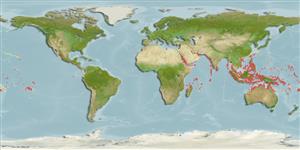>
Gobiiformes (Gobies) >
Microdesmidae (Wormfishes) > Ptereleotrinae
Etymology: Parioglossus: Greek, pareia = jaw + Greek, glossa = tongue (Ref. 45335).
Eponymy: Professor Dr H Srinivasa Rao (1894–1971) was an Indian zoologist who specialised in faunistic morphology. [...] (Ref. 128868), visit book page.
More on author: Herre.
Environment: milieu / climate zone / depth range / distribution range
Ökologie
seewasser; brackwasser riff-verbunden. Tropical; 30°N - 20°S
Indo-West Pacific: Arabian Gulf and the Gulf of Oman (Ref. 11441) to Fiji, north to the Ryukyu Islands, south to Indonesia. Recently recorded from Tonga (Ref. 53797).
Size / Gewicht / Alter
Maturity: Lm ? range ? - ? cm
Max length : 3.5 cm SL Männchen/unbestimmt; (Ref. 48637)
Rückenflossenstacheln (insgesamt) : 7; Rückenflossenweichstrahlen (insgesamt) : 14 - 16; Afterflossenstacheln: 1; Afterflossenweichstrahlen: 14 - 16. Body yellowish brown with a black longitudinal stripe and a bright blue spot between dorsal spines 5 and 6. SL to 25 mm (Ref. 1602).
Inhabits mangrove swamps and inlet waters (Ref. 559); shallow coastal waters with mud, sand, or rock bottoms (Ref. 1602). Forms aggregations near surface (Ref. 90102).
Life cycle and mating behavior
Geschlechtsreife | Fortpflanzung | Ablaichen | Eier | Fecundity | Larven
Masuda, H., K. Amaoka, C. Araga, T. Uyeno and T. Yoshino, 1984. The fishes of the Japanese Archipelago. Vol. 1. Tokai University Press, Tokyo, Japan. 437 p. (text). (Ref. 559)
IUCN Rote Liste Status (Ref. 130435: Version 2024-2)
Bedrohung für Menschen
Harmless
Nutzung durch Menschen
Tools
Zusatzinformationen
Download XML
Internet Quellen
Estimates based on models
Preferred temperature (Ref.
123201): 26.4 - 29.3, mean 28.5 °C (based on 3075 cells).
Phylogenetic diversity index (Ref.
82804): PD
50 = 0.5000 [Uniqueness, from 0.5 = low to 2.0 = high].
Bayesian length-weight: a=0.00389 (0.00180 - 0.00842), b=3.12 (2.94 - 3.30), in cm total length, based on all LWR estimates for this body shape (Ref.
93245).
Trophic level (Ref.
69278): 3.2 ±0.4 se; based on size and trophs of closest relatives
Fishing Vulnerability (Ref.
59153): Low vulnerability (10 of 100).
